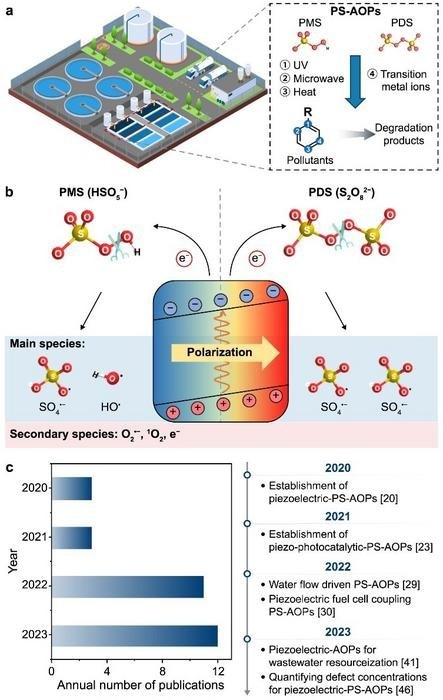The increasing size and speed of urbanization are leading to a significant issue of water pollution.
 a, Traditional Activation Method of Ps-Aops Technology. b, Mechanism of Piezoelectric/Ps-Aops. c, Annual Number of Publications Concerning Piezoelectric/Ps-Aops. Image Credit: Environmental Science and Ecotechnology
a, Traditional Activation Method of Ps-Aops Technology. b, Mechanism of Piezoelectric/Ps-Aops. c, Annual Number of Publications Concerning Piezoelectric/Ps-Aops. Image Credit: Environmental Science and Ecotechnology
Effective methods are needed to clean the water. Conventional cleaning techniques, such as Persulfate (PS)-Advanced Oxidation Processes (AOPs), are effective at eliminating the contaminants in the water, but they are energy- and chemical-intensive, requiring metal ions and special light, a process that is expensive and bad for the environment.
Researchers from Jinan University described a novel, environmentally benign method of purifying water in a recent study published in the journal Environmental Science and Ecotechnology. A technique known as “piezoelectric activation of PS” has been found. This method uses unique materials that, when squeezed or pressed, produce piezoelectricity, which cleans the water.
The amazing thing is that natural forces like wind, waves in the ocean, or currents in rivers can cause this squeezing. This means that it is an extremely energy-efficient and environmentally friendly method of sanitizing water.
The goal of the research on piezoelectric/PS-AOPs is to develop novel methods of water treatment through specialized processes. Materials that can produce piezoelectricity when compressed or squeezed are used in this process.
After that, a chemical known as persulfate is activated using this piezoelectricity to aid in the breakdown of dangerous materials in the water. To improve this process, scientists are experimenting with various materials such as ZnO, MoS₂, and BaTiO₃. They had to deal with issues like slow electron mobility and insufficient energy extraction from the materials, but they are developing better materials to address these issues.
An environmentally responsible and sustainable method of powering this process is the utilization of wind and water flow. Beyond merely purifying water, this new technology has the potential to convert harmful substances in the water into beneficial substances. This makes it a very promising method for environmental remediation when it comes to cleaning water. As research continues, this approach—which uses renewable energy sources and is environmentally friendly—may emerge as a major means of treating water and reducing pollution.
Piezoelectric activation of persulfate represents a paradigm shift in water treatment technology. It not only addresses the efficiency and environmental concerns associated with traditional methods but also opens up new pathways for using renewable energy sources.
Dr. Mingshan Zhu, Jinan University
He emphasized the significance of this development.
The way water is purified is changing thanks to this innovative technique. It is energy-efficient, environmentally friendly, and very successful at reducing water pollution. This method contributes significantly to environmental protection in addition to improving water quality, marking a huge step towards a healthier and cleaner world.
Journal Reference:
Li, Z., et al. (2024). Piezoelectricity activates persulfate for water treatment: A perspective. Environmental Science and Ecotechnology. doi.org/10.1016/j.ese.2023.100329.